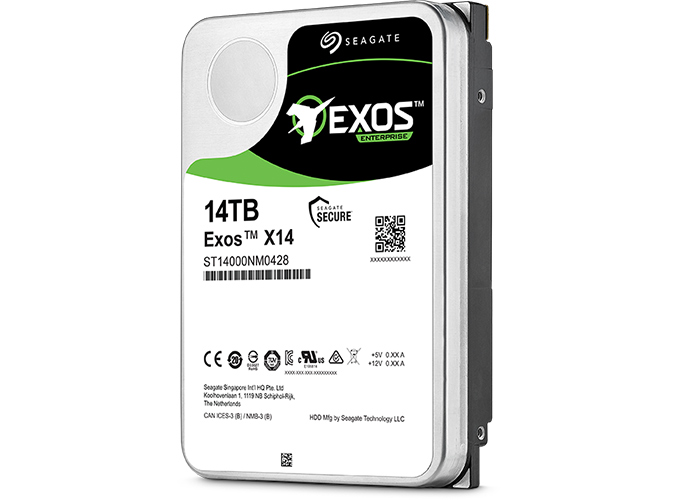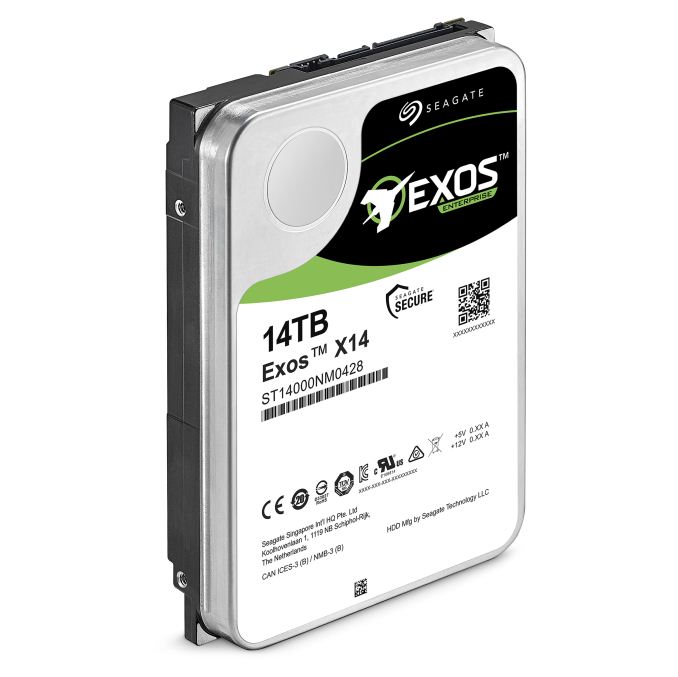Seagate Announces Exos X14: a Helium-Filled 14 TB PMR HDD
by Anton Shilov on March 21, 2018 11:00 AM EST
Seagate this week formally introduced its first hard drive with 14 TB capacity aimed at cloud datacenters that does not use shingled magnetic recording. The new Exos X14 HDDs are filed with helium and are based on the latest-generation PMR (perpendicular magnetic recording) platters, running at 7200 RPM.
Update: Seagate has officially confirmed that the Exos 14 is based on eight PMR platters and uses TDMR heads.
It is logical to expect the drive to rely on a brand-new platform that uses eight 1.75-TB platters and uses two-dimensional magnetic recording (TDMR) to ensure predictable read performance of very thin tracks. Since the drive is filled with helium, helium drives can typically boast a relatively low power consumption, however we await further details. Similarly, because of increased areal density, the new drive should also offer higher sequential data transfer rate than its predecessors. Seagate does report that the drive has higher random I/O responsiveness than ancestors and rivals.
In addition to higher capacity and performance, the Seagate Exos X14 features Seagate Secure hardware encryption technology. Also, the new HDD is FIPS 140-2/Level 2 and ISO/EIC 15408 certified, meeting governments’ requirements for secure storage of data.
The Exos X14 is Seagate’s response to Toshiba’s MG07ACA HDD with 14 TB capacity announced last year, although until we recieve further information, we cannot do a direct comparison. The major benefit of both drives is their increased capacity that enables datacenter operators to store 3360 TB of data per rack (compared to 2440 TB with 10 TB HDDs), which is a key advantage for companies that need to maximize their storage capacity per square meter and per watt, while meeting other TCO objectives. Another indisputable win of 14 TB hard disks from Seagate and Toshiba (vs. HGST’s Ultrastar Hs14) is their conventional magnetic recording technology, which ensures predictable writing performance and permits drop in compatibility of the HDDs with existing storage applications.
Seagate’s Exos X14 is currently sampled with select customers, such as Baidu. The manufacturer plans to start volume shipments of the Exos X14 this summer, but does not disclose exact availability timeframe or approximate pricing. Keep in mind that Toshiba’s MG07ACA HDD with 14 TB capacity will ship in Q2, so Seagate’s Exos X14 will have at least one rival when it becomes available later this year.
Related Reading
- Toshiba Announces 14 TB PMR MG07ACA HDD: 9 Platters, Helium-Filled, 260 MB/s
- Western Digital Now Shipping 14 TB HDDs: HGST Ultrastar Hs14 with 1000 Gb/in2
- Western Digital Announces Ultrastar He12 12 TB and 14 TB HDDs
- Seagate Announces Enterprise Capacity 12 TB HDD: 2nd-Gen Helium-Filled Hard Drives
- Western Digital Ships 12 TB WD Gold HDD: 8 Platters and Helium
- Toshiba Unveils 10TB HDDs for Video Surveillance: Support for up to 64 HD Streams
Source: Seagate











10 Comments
View All Comments
iter - Wednesday, March 21, 2018 - link
"that does not use shingled magnetic recording"Praise Gilgamesh!
Chaitanya - Wednesday, March 21, 2018 - link
what is platter density of these drives?PeachNCream - Wednesday, March 21, 2018 - link
Desktop hard drive platters are almost all made of aluminum so their density is going to be roughly 2.70 grams per cubic centimeter.iter - Wednesday, March 21, 2018 - link
Pretty sure they move away from that.edzieba - Wednesday, March 21, 2018 - link
I don't know of any drives that still use aluminum platters, everyone transitioned to glass/ceramic a decade ago.Samus - Thursday, March 22, 2018 - link
Some of the first drives with glass platters were the 2003-era IBM Deathstar GXP's (first gen 75GXP, next gen 60GXP) and we all know how that turned out...the issues have since obviously been ironed out. The problem really came down to the heads not being engineered for glass platters.PeachNCream - Thursday, March 22, 2018 - link
That's odd. I've seen lots of 2.5 inch hard drives with glass platters, but I've had to destroy lots and lots of 3.5 inch drives over the years and none of them that have been through the crusher shatter. They're all nice bendy aluminum and usually no more than about 3 years old (if they haven't had a premature failure anyhow). You can always tell the glass and ceramic ones because they leave a shattered mess inside the drive and some of it finds its way out after crushing to leave a mess to sweep up from the inside of the machines. :)ZeDestructor - Thursday, March 22, 2018 - link
They're back to coated aluminium these daysHurr Durr - Wednesday, March 21, 2018 - link
I`d like to know when 14 or at least 12TB will be available in their tabletop backup series.takeshi7 - Thursday, March 22, 2018 - link
Can the tech press please start using "CMR" or "conventional magnetic recording" in order to differentiate that the drive isn't "SMR" or "shingled magnetic recording"?Using PMR is just bad semantics because all modern hard drives are PMR regardless of whether they are shingled or not.